| Listing 1 - 10 of 12 | << page >> |
Sort by
|
Book
ISBN: 2600001263 9782600001267 Year: 1996 Volume: 19 19 Publisher: Genève Droz
Abstract | Keywords | Export | Availability | Bookmark
 Loading...
Loading...Choose an application
- Reference Manager
- EndNote
- RefWorks (Direct export to RefWorks)
Bible. --- Commentaries. --- 227.1*9 --- Brief van Paulus aan de Hebreeën --- 227.1*9 Brief van Paulus aan de Hebreeën
Book
ISBN: 3161447905 3161448693 9783161448690 Year: 1984 Volume: 14 Publisher: Tübingen Mohr Siebeck
Abstract | Keywords | Export | Availability | Bookmark
 Loading...
Loading...Choose an application
- Reference Manager
- EndNote
- RefWorks (Direct export to RefWorks)
Bible. --- Commentaries. --- #gsdb1 --- 227.1*9 --- 227.1*9 Brief van Paulus aan de Hebreeën --- Brief van Paulus aan de Hebreeën --- Epistle to the Hebrews --- Hebräerbrief (Book of the New Testament) --- Hebrews (Book of the New Testament) --- Poslanie do Evreite (Book of the New Testament) --- Risālah ilá al-ʻIbrānīyīn (Book of the New Testament)
Book
ISSN: 01679732 ISBN: 9789004460164 9789004460171 9004460160 9004460179 Year: 2021 Volume: 184 Publisher: Leiden Brill
Abstract | Keywords | Export | Availability | Bookmark
 Loading...
Loading...Choose an application
- Reference Manager
- EndNote
- RefWorks (Direct export to RefWorks)
"In the collection entitled Deciphering the Worlds of Hebrews Gabriella Gelardini gathers fifteen essays written in the last fifteen years, twelve of which are in English and three in German. Arranged in three parts (the world of, behind, and in front of Hebrews's text), her articles deal with such topics as structure and intertext, sin and faith, atonement and cult, as well as space and resistance. She reads Hebrews no longer as the enigmatic and homeless outsider within the New Testament corpus, as the "Melchizedekian being without genealogy"; rather, she reads Hebrews as one whose origin has finally been rediscovered, namely in Second Temple Judaism"--
Bible. --- Criticism, interpretation, etc. --- Bible --- New Testament --- 227.1*9 --- 227.1*9 Brief van Paulus aan de Hebreeën --- Brief van Paulus aan de Hebreeën --- Epistle to the Hebrews --- Hebräerbrief (Book of the New Testament) --- Hebrews (Book of the New Testament) --- Poslanie do Evreite (Book of the New Testament) --- Risālah ilá al-ʻIbrānīyīn (Book of the New Testament)
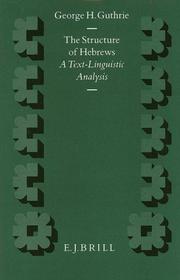
ISBN: 9004098666 9004267069 9789004267060 9789004098664 Year: 1994 Volume: 73 Publisher: Leiden Brill
Abstract | Keywords | Export | Availability | Bookmark
 Loading...
Loading...Choose an application
- Reference Manager
- EndNote
- RefWorks (Direct export to RefWorks)
One of the focal issues surrounding contemporary studies of Hebrews concerns the book's elusive structure. This volume presents an examination of previous proposals and a fresh attempt at unlocking Hebrews' organizational principles. The first part of the volume critically assesses past efforts at outlining Hebrews. Following a history of investigation, the various approaches to the structure of Hebrews are categorized and evaluated for both strengths and weaknesses. Methodologies considered include thematic analysis, literary analysis, rhetorical analysis, and linguistic analysis. Part two of the volume offers a texts-linguistic analysis of Hebrews, utilizing both modern linguistic theory and insight into ancient oratorical conventions. This book presents advances in text-linguistic analysis and a compelling proposal concerning the structure of Hebrews.
Bible. N.T. Hebrews --- Bible. --- Criticism, interpretation, etc --- Critique, interprétation, etc. --- Bible --- 227.1*9 --- Brief van Paulus aan de Hebreeën --- 227.1*9 Brief van Paulus aan de Hebreeën --- Critique, interprétation, etc. --- Epistle to the Hebrews --- Hebräerbrief (Book of the New Testament) --- Hebrews (Book of the New Testament) --- Poslanie do Evreite (Book of the New Testament) --- Risālah ilá al-ʻIbrānīyīn (Book of the New Testament) --- Criticism, interpretation, etc.
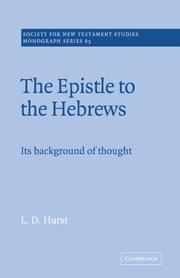
ISBN: 0521370973 0521673402 0511554974 0511875800 9780521370974 9780521673402 9780511554971 Year: 1990 Volume: 65 Publisher: Cambridge Cambridge University press
Abstract | Keywords | Export | Availability | Bookmark
 Loading...
Loading...Choose an application
- Reference Manager
- EndNote
- RefWorks (Direct export to RefWorks)
This work is a comprehensive treatment of one of the most intriguing questions of modern New Testament study: what kind of person could have produced the mysterious document known today as the Epistle to the Hebrews? While other studies of Hebrews have tended to focus either on the question of the identity of the writer and of the letter's recipients, or on individual issues such as the writer's view of priesthood, religious pilgrimage or christology, Dr Hurst provides the first work to explore in a comprehensive way the important question of what specifically identifiable milieus might have produced a document which for many people seems something of an alien presence within the New Testament. The book is organised around the widely differing backgrounds of thought which have to be considered - such as Platonism, the beliefs of the Dead Sea Sect and of the early gnostics (as well as those of St Stephen and St Paul) - and it explores in depth the major theological and philosophical problems faced by first-century Christians.
Bible --- Criticism, interpretation, etc --- 227.1*9 --- Brief van Paulus aan de Hebreeën --- 227.1*9 Brief van Paulus aan de Hebreeën --- Bible. --- Epistle to the Hebrews --- Hebräerbrief (Book of the New Testament) --- Hebrews (Book of the New Testament) --- Poslanie do Evreite (Book of the New Testament) --- Risālah ilá al-ʻIbrānīyīn (Book of the New Testament) --- Criticism, interpretation, etc. --- Arts and Humanities --- Religion
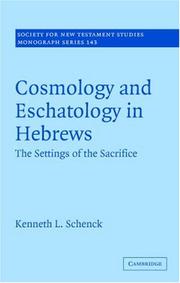
ISBN: 9780521883238 9780511488177 9780521130479 0511488173 9780511379239 0511379234 1107185807 9781107185807 1281243787 9781281243782 9786611243784 661124378X 0511377487 9780511377488 0511376545 9780511376542 0511375018 9780511375019 0521883237 0521130476 051137836X Year: 2007 Volume: 143 Publisher: Cambridge Cambridge university press
Abstract | Keywords | Export | Availability | Bookmark
 Loading...
Loading...Choose an application
- Reference Manager
- EndNote
- RefWorks (Direct export to RefWorks)
Scholars argue over where Hebrews fit in the first century world. Kenneth L. Schenck works towards resolving this question by approaching Hebrews' cosmology and eschatology from a text-orientated perspective. After observing that the key passages in the background debate mostly relate to the 'settings' of the story of salvation history evoked by Hebrews, Schenck attempts to delineate those settings by asking how the 'rhetorical world' of Hebrews engages that underlying narrative. Hebrews largely argue from an eschatology of two ages, which correspond to two covenants. The fresh age has come despite the continuance of some old age elements. The most characteristic elements of Hebrews' settings, however, are its spatial settings, where we find an underlying metaphysical dualism between the highest heaven, which is the domain of spirit, and the created realm, including the created heavens. This creation will be removed at the eschaton, leaving only the unshakeable heaven.
Biblical cosmology. --- Eschatology --- Cosmologie biblique --- Eschatologie --- Biblical teaching. --- Enseignement biblique --- Bible. --- Criticism, interpretation, etc. --- 227.1*9 --- Cosmology, Biblical --- Cosmology --- Creation --- Brief van Paulus aan de Hebreeën --- Epistle to the Hebrews --- Hebräerbrief (Book of the New Testament) --- Hebrews (Book of the New Testament) --- Poslanie do Evreite (Book of the New Testament) --- Risālah ilá al-ʻIbrānīyīn (Book of the New Testament) --- 227.1*9 Brief van Paulus aan de Hebreeën --- Biblical cosmology --- Biblical teaching --- Arts and Humanities --- Religion --- Eschatology - Biblical teaching.
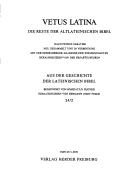
ISBN: 3451219360 9783451219368 Year: 1991 Volume: 20 Publisher: Freiburg Herder
Abstract | Keywords | Export | Availability | Bookmark
 Loading...
Loading...Choose an application
- Reference Manager
- EndNote
- RefWorks (Direct export to RefWorks)
Bible. --- Codex Claromontanus. --- Manuscripts, Greek. --- Manuscripts, Latin. --- Language, style. --- 091 <44 PARIS> --- 091 =75 --- 225.014*2 --- 227.1*9 --- #GOSA:I.NT.Pa.M --- #GROL:SEMI-22.04=71 Vetu E 20 --- Handschriftenkunde. Handschriftencatalogi--Frankrijk--PARIS --- Handschriftenkunde. Handschriftencatalogi--Grieks --- Nieuw Testament: geschiedenis van de grondtekst en de oude vertalingen --- Brief van Paulus aan de Hebreeën --- 227.1*9 Brief van Paulus aan de Hebreeën --- 225.014*2 Nieuw Testament: geschiedenis van de grondtekst en de oude vertalingen --- 091 =75 Handschriftenkunde. Handschriftencatalogi--Grieks --- 091 <44 PARIS> Handschriftenkunde. Handschriftencatalogi--Frankrijk--PARIS
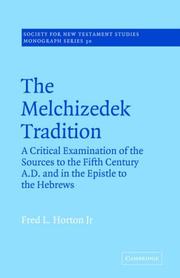
ISBN: 0521210143 0521018714 0511554966 0511864965 9780521210140 9780511554964 9780521018715 Year: 1976 Volume: 30. Publisher: Cambridge Cambridge University press
Abstract | Keywords | Export | Availability | Bookmark
 Loading...
Loading...Choose an application
- Reference Manager
- EndNote
- RefWorks (Direct export to RefWorks)
This monograph seeks to answer the question why Melchizedek, who is a minor figure in the Old Testament, is selected by the author of the Epistle to the Hebrews to represent the priesthood of Christ. In the course of his study, Professor Horton surveys the traditions about Melchizedek from the Old Testment period, in Philo, Josephus and Qumran, to the later sources in Rabbinical and patristic writings and the Gnosticism. The book concludes with a critical examination of the claims made for the dependence of Hebrews on the Qumran figure and tradition. The author finally rejects this interpretation in favour of a source and background for Hebrews in an independent and largely original interpretation of the Old Testament passages.
Melchizedek, --- Bible. N.T. Hebrews --- Criticism, interpretation, etc --- 227.1*9 --- #GROL:SEMI-225<08> Soci 30 --- #GROL:SEMI-227.1*9 --- Brief van Paulus aan de Hebreeën --- Melchizedek King of Salem --- 227.1*9 Brief van Paulus aan de Hebreeën --- Melchisedech, --- Melchi-Zedek, --- Malki-Tsedeḳ, --- Melchisedec, --- Melkitsedeq, --- Melchisedek, --- Bible. --- Epistle to the Hebrews --- Hebräerbrief (Book of the New Testament) --- Hebrews (Book of the New Testament) --- Poslanie do Evreite (Book of the New Testament) --- Risālah ilá al-ʻIbrānīyīn (Book of the New Testament) --- Criticism, interpretation, etc. --- Arts and Humanities --- Religion --- Legends --- Folk tales --- Traditions --- Urban legends --- Folklore
Book
ISBN: 2204016993 9782204016995 Year: 1981 Publisher: Paris Cerf
Abstract | Keywords | Export | Availability | Bookmark
 Loading...
Loading...Choose an application
- Reference Manager
- EndNote
- RefWorks (Direct export to RefWorks)
Bible. N.T. Hebrews --- Bible. --- Criticism, interpretation, etc --- Critique, interprétation, etc. --- Bible. N.T. Epître aux Hébreux (français). 1981. Dussaut, L. --- Bible --- 227.1*9 --- Brief van Paulus aan de Hebreeën --- 227.1*9 Brief van Paulus aan de Hebreeën --- Critique, interprétation, etc. --- Epistle to the Hebrews --- Hebräerbrief (Book of the New Testament) --- Hebrews (Book of the New Testament) --- Poslanie do Evreite (Book of the New Testament) --- Risālah ilá al-ʻIbrānīyīn (Book of the New Testament) --- Criticism, interpretation, etc.
Book
ISSN: 01679732 ISBN: 9789004339507 9789004339514 9004339515 9004339507 Year: 2017 Volume: 171 Publisher: Brill
Abstract | Keywords | Export | Availability | Bookmark
 Loading...
Loading...Choose an application
- Reference Manager
- EndNote
- RefWorks (Direct export to RefWorks)
In Hebrews and the Temple Philip Church argues that the silence of Hebrews concerning the temple does not mean that the author is not interested in the temple. He writes to encourage his readers to abandon their preoccupation with it and to follow Jesus to their eschatological goal. Following extensive discussions of attitudes to the temple in the literature of Second Temple Judaism, Church turns to Hebrews and argues that the temple is presented there as a symbolic foreshadowing of the eschatological dwelling of God with his people. Now that the eschatological moment has arrived with the exaltation of Christ to the right hand of God, preoccupation with the temple and its rituals must cease.
Judaism --- History --- Temple of Jerusalem (Jerusalem) --- Bible. --- Criticism, interpreation, etc. --- Judaïsme --- Histoire --- Bible --- Criticism, interpretation, etc --- 227.1*9 --- 227.1*9 Brief van Paulus aan de Hebreeën --- Brief van Paulus aan de Hebreeën --- Judaïsme --- Hellenistic Judaism --- Judaism, Hellenistic --- Epistle to the Hebrews --- Hebräerbrief (Book of the New Testament) --- Hebrews (Book of the New Testament) --- Poslanie do Evreite (Book of the New Testament) --- Risālah ilá al-ʻIbrānīyīn (Book of the New Testament) --- Criticism, interpretation, etc. --- Judaism - History - Post-exilic period, 586 B.C.-210 A.D.
| Listing 1 - 10 of 12 | << page >> |
Sort by
|

 Search
Search Feedback
Feedback About UniCat
About UniCat  Help
Help News
News